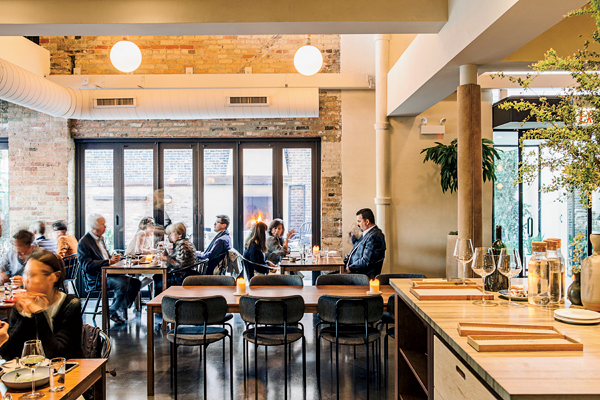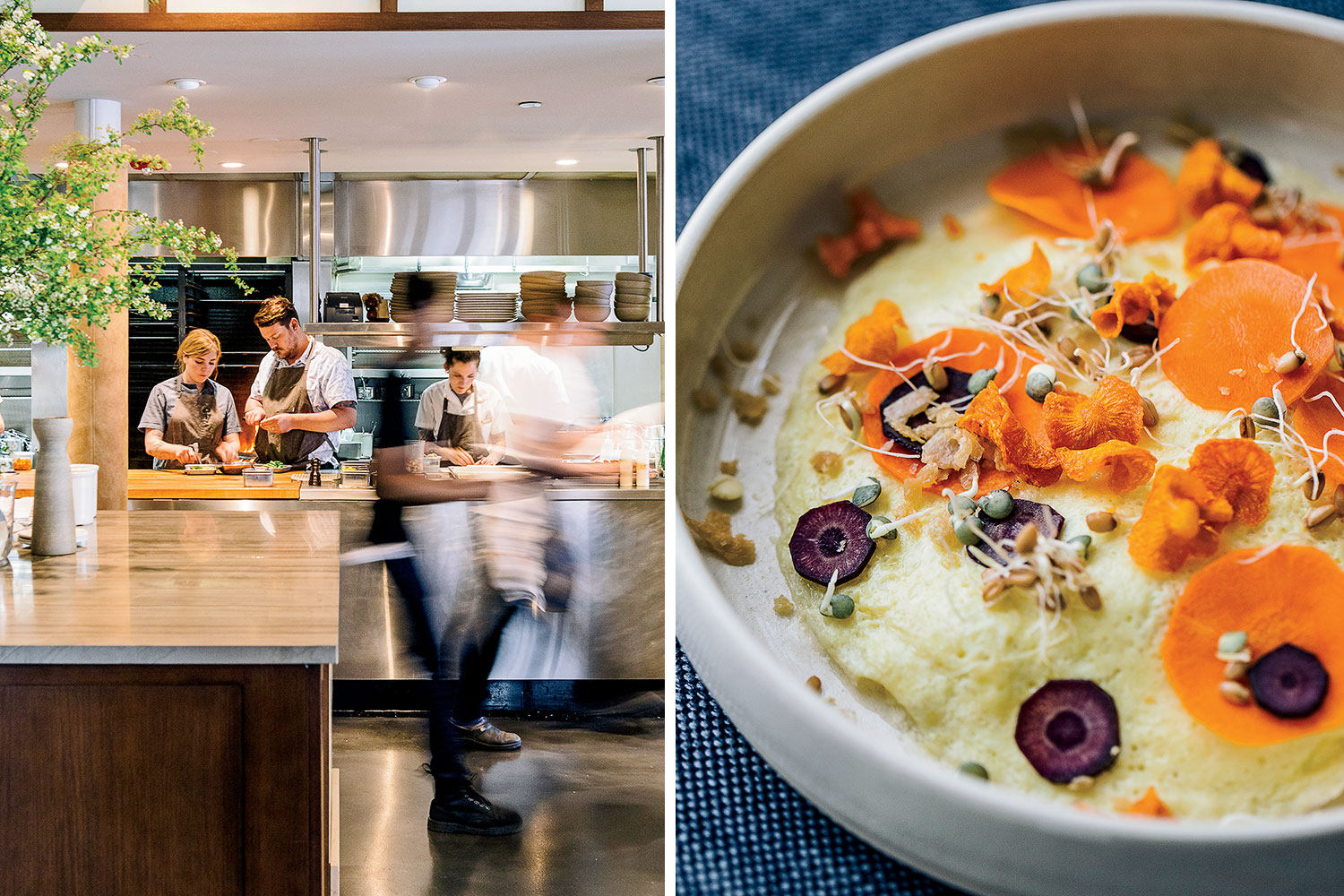It may not be fashionable to admit these days, but I love tasting menus. They’re wide-open canvases that chefs can paint any number of ways to provide glimpses into their brains and hearts, and the unpredictable format has a tendency to amplify a chef’s strengths or flaws. Disparaging a tasting menu can feel strangely personal, like critiquing someone’s private diary.
When I heard that Elske, David and Anna Posey’s Danish-inspired restaurant in the West Loop, would have an eight-course prix fixe menu, I got excited. I loved David’s James Beard Award–winning cooking as chef de cuisine at Blackbird and Anna’s desserts at the Publican. I was also intrigued by the price and the pace of the meal: $85 and less than two hours. That sounded like a dinner I could enjoy more than once, as opposed to a single wallet-draining, time-sucking splurge. Others seem to agree: 40 percent of Elske’s diners opt for the set menu.
The white-toned contemporary space at the west end of Randolph Street’s Restaurant Row is outfitted with a pristine banquette, light-colored wood tables set with candles, and a courtyard with a crackling fireplace and love seats draped with white reindeer fur blankets. It’s all meant to capture hygge, the elusive Danish concept of coziness, calm, and welcoming. But even the most streamlined tasting menu feels vaguely show-offy by nature, a grand declaration that seems at odds with the Scandinavian understatement that Elske tries so hard to project. Could the Poseys pull it off?
In short, no. From the opening salvo, the entire prix fixe experience felt disjointed, more jarring than comforting. Elske wraps a delicately slow-roasted carrot in a crispy sourdough bundle with mussel cream, then obliterates it by pairing it with a deliberately aggressive bittersweet tea made with lightly smoked turnips, celery, and celery root. The combination obliterated my expectations too.
The eclectic procession that followed meandered this way and that, as if in search of a unifying theme. While the food is not strictly Danish, the lack of any other defining influence left me feeling adrift. Some dishes, such as a peppy beef tartare with pickles and crispy onions atop a ketchupy rémoulade (Elske’s take on a grillpølser, or a Danish hot dog), ventured into cutesy-gimmicky territory. Others, such as a wedge of duck liver tart with a nutty buckwheat crust, salted ramp juice, and a sprinkle of dried parsley powder, were austere and ultimately listless. Then there was the absurd leek vinaigrette with toasted oats, black olives, an oozing mass of hollandaise, and an overdose of Bleu Mont Dairy cheddar—an act of cartoonishly blunt excess that seemed to have come from a different kitchen entirely. (Warm poppy seed rolls tried their valiant best to soak this one up.)
Hints of what I had hoped for did occasionally shine through. David lightly grills a pair of steak-like lamb loin chops and stacks them vertically, a broccoli purée studded with butter-fried almonds acting as a creamy mortar. Ramps, steamed broccoli stems, and minutina (a nutty-tasting green) cut the lush flavors. And the second of two desserts by Anna, a sharp kaffir lime custard packed into a sunchoke tuile, topped with sunchoke chips, and anchored by gelled Chartreuse, transcended everything that preceded it.
My overall impression: Elske has a skilled kitchen that, unsure what direction to take, decided to go in one that’s completely at odds with the restaurant’s carefully cultivated feel. And the promise of a quick pace was taken to an extreme by blasé servers. Food runners delivered dishes so fast and unceremoniously that they may as well have been Usain Bolt. So much for hygge: I’ve had warmer welcomes at my neighborhood CVS.

Only masochists and dining critics go back to a restaurant they didn’t much care for the first time. I returned under the impression that I would find Elske’s à la carte menu equally off-putting. But, again, the restaurant surprised me.
The servers were far more relaxed—more hygge, if you will—with the à la carte structure. They delivered shareable items three at a time, each dish echoing the other in a nuanced way that felt—oddly enough—more gracefully choreographed than the prix fixe did. A trio of seafood dishes consisted of tender grilled sepia (cuttlefish) under wavy sheets of hearth-roasted turnips with smoked onion yogurt; smoked trout slices atop puffed buckwheat with marshmallow-like rounds of stewed white asparagus; and crisp-edged skate wing with caramelized onion purée, tiny rye croutons, and fringed leaves of coraline (a sweet yellow lettuce). All three plates were gorgeous and perfectly balanced.
The rest of the evening, during which I saw a chef snip herbs from the courtyard garden, played out in a similar fashion. The grilled shiitake mushrooms with toothy fava beans, creamed barley, and green garlic were rich and lively. Fermented black bean agnolotti with peak-season morels and a sprinkling of sugar peas and pea shoots served as a case study in the art of simplicity and concentrated flavor. The highlight, unexpectedly, was a plate of scrambled eggs inspired by a dish David’s Danish mother made for Christmas a few years back. He mixes eggs with cream cheese to keep them soft and warms them alongside chicken thighs that have been salted overnight and made into a confit. Then he tops the whole thing with a thin sheet of barely set egg, crispy chicken skin, fried carrot disks, and multiple sprouted grains. The preparation is texturally stunning and complex, cosseting the tongue with brown butter, then tweaking it with lemon juice.
In fact, of the 12 dishes I tried on this visit, savory and sweet, I adored no fewer than 10. (The only real misstep, an undercooked roasted quail, almost got redeemed by garlicky walnut skordalia, wax beans, and an abundance of dill.) Anna’s three desserts take giant, creative chances. The biggest payoff was the odd-looking square of honey-dripped sunflower seed parfait that cozied up to a powdery mound of bee pollen. I’d never tasted anything like it. And the Berliner weisse from Copenhagen, served on tap and a highlight of Kyle Davidson’s beverage program, unlocked all kinds of tart and taut flavor combinations.
So what happened? How could Elske, a highly professional operation, succeed so admirably in one format yet fall flat in the other? My experience suggests that the restaurant reaches its mellow, informal Scandinavian ideal when it’s free of the pressure of an overreaching, look-at-me statement. As one local chef says: “A tasting menu is pretty much ‘Here’s what I got—you get all of it and you are going to judge me on everything.’ That’s a lot harder than someone ordering trout because they love trout.” At Elske, the trout is the way to go.



